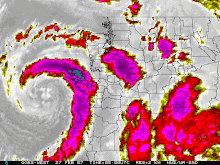Eugene broke the one day rainfall record for today, September 31st. Portland is close and I will update any other records if they are broken. Here is a story from Kansas City. Looks like they are trying to cloud seed.
Kansas weather modification program relies on ‘cloud seeding’
By MARIA SUDEKUM FISHER
The Associated Press
LAKIN, Kan. | Water is prized in western Kansas, where aquifers are suffering and farms are miles wide and generations deep.
A scant half inch of rain can mean the difference between a successful season and a failed one. But when it comes in the form of fist-sized balls of ice known as hail, water’s more than a menace. It can damage and even destroy crops.
That’s where the Western Kansas Weather Modification Program and other cloud-seeding operations across the western U.S. come in. The program is among about 10 that tinker with the weather — either by trying to cut the size of hail or boost rainfall and snowpack. They do it largely by shooting up storm clouds with silver iodide or dry ice mixtures.
Cloud seeding has a host of critics, from those who say there is no good science to support claims that it works to others who raise concerns about the possibility that it actually may cause less rain and harm the environment.
Cloud seeding was developed after World War II to try to increase rainfall. The theory is that the silver iodide, which has a structure that resembles ice, creates raindrops in the clouds, increasing precipitation and reducing moisture for hail formation.
A measure before the U.S. Senate would allocate $10 million a year to establish an agency that would develop policy and research weather modification programs.
Kansas started its program in 1975. The Western Kansas Weather Modification Program now covers about 8,000 miles and is used about 85 percent of the time for hail reduction. The program, which receives state and local funding, was briefly extended into northwest Kansas in the late 1990s. But residents became concerned that cloud seeding may have been reducing their rainfall amounts and voted the program out.
The program operates from April through September with four planes. Program manager Walt Geiger monitors the weather from a radar station. When he sees a storm developing, one with “lots of strong vertical action” that could be a hail producer, Geiger notifies the pilots, who then head into the storms armed with canisters of silver iodide.
A 1998-1999 study of the Kansas program found that while there was a statistically significant reduction in hail that year, there was no evidence to support the program’s attempts to increase rainfall.
David Brenn, the program’s director, says he has seen the benefits of hail reduction efforts. He also says at least one insurance company has expressed interest in partnering with the program.
But Mike Standley, whose family has farmed in southwest Kansas for about a century, says he’s concerned that cloud seeding may be costing him some precious rain. It has been a long time since he has seen regular summer afternoon thunderstorms on his land, says Standley, 30.
Standley says he would like to see solid proof that cloud seeding works. With 14 to 19 inches of precipitation a year, he just can’t spare the moisture. “I can raise crops with hail,” he said. “But I can’t raise crops with no moisture.”
Sunday, September 30, 2007
Subscribe to:
Post Comments (Atom)

1 comment:
cloud seeding helps augment rainfall by 25 to 30percent by conducting warm and cxold cloud seeding operations as per standard procedures followed in Tasmania or Texas or China where 65 billion cubic meters additional annual rainfall is obtained by employing 37000technicians to fight the recurring droughts unlike in USA where the UA Academy is opposing cloud seeding on flimsy grounds to the detriment of the poor people and national economc growth.Kansas must continue cloud seeding on scientific lines to save mankind and nature.
prof.T.shivaji rao.M.s.[Rice,Texas.1962]
Director,Gitam University,visakhapatnam
Post a Comment